Maintaining the beauty of both your area rug and hardwood floor requires the right cleaning methods. If you’re wondering how to clean an area rug on a hardwood floor, it’s essential to strike a balance that keeps your rug spotless without harming the delicate hardwood beneath. From dusting to deep cleaning, knowing the proper techniques will help preserve the longevity of both surfaces while ensuring your home remains fresh and welcoming. In this guide, we’ll explore safe and effective ways to clean your area rug without risking damage to your hardwood floor.
Why Cleaning Area Rugs on Hardwood Floors Requires Special Care
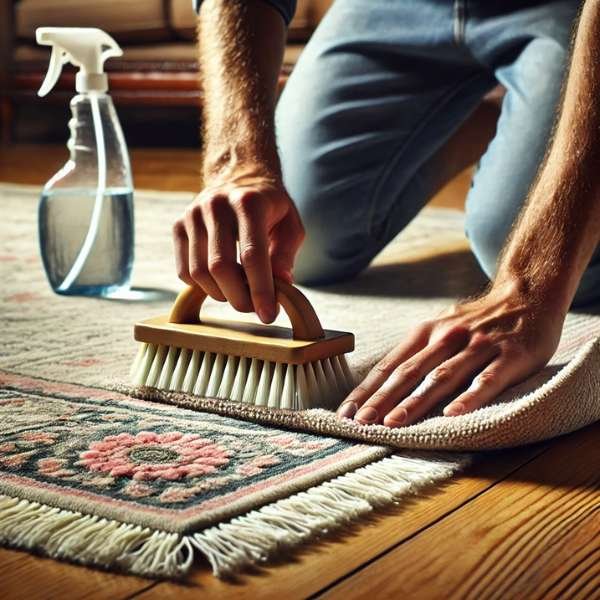
Cleaning an area rug on hardwood involves a delicate balancing act. On one side, rugs trap dirt, dust, and allergens. On the other, hard lumber floors are prone to water damage, staining, and scratching. You can’t just scrub the carpet carelessly or pour water onto it. No, you need finesse. Harsh cleaning methods could wreck both the carpet’s fibers and the wood’s finish. It’s a matter of taking it slow, steady and using the right approach.
Preparing Your Area Rug and Hardwood Floor for Cleaning

Preparation is half the battle. Before getting into the actual cleaning, you need to remove any dust and debris lurking around. Roll back the rug, sweep the floor beneath to ensure no grit scratches on the hardwood, and examine both the carpet and the floor for any pre-existing stains or scratches. Knowing where the trouble spots are will help you address them directly.
Essential Tools and Supplies for Cleaning an Area Rug on Hardwood Floor

A well-equipped cleaner is a successful one. Gather the essentials: a vacuum with a soft brush attachment, a mild cleaning solution (organic or pH-neutral), a microfiber cloth, a soft-bristle brush, and some old towels. These tools allow for effective cleaning without causing harm to the hardwood below. Skip the harsh chemicals; they’re a recipe for disaster, stripping fibers and damaging wood finishes. Instead, embrace natural cleaning solutions like vinegar or baking soda.
How Often Should You Clean an Area Rug on Hardwood Flooring?

It’s all about location and usage. A rug in a high-traffic zone? Vacuum it weekly, and give it a deeper cleaning every couple of months. A carpet in a quiet corner? A quarterly deep clean should suffice. Spills, however, should be tackled immediately. Letting them linger could mean bigger issues down the road.
Common Mistakes to Avoid When Cleaning an Area Rug on Hardwood Flooring
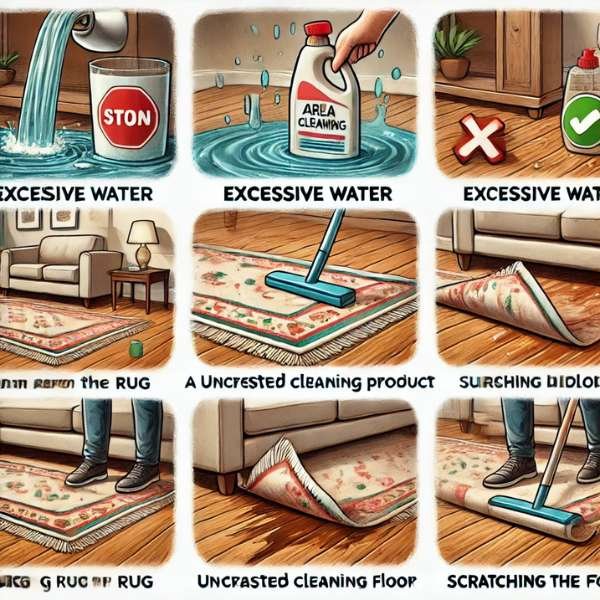
There are pitfalls to avoid, too. Too much water? That’s asking for trouble—water can seep through and damage the hardwood. Using untested products? Risky! Always test a small section of the carpet to ensure there’s no discoloration. Ignoring the rug’s backing? A rough backing can scratch the hardwood. And never, ever drag the carpet across the floor—it’ll leave nasty marks.
Step-by-Step Guide to Dusting and Vacuuming Area Rugs

Vacuuming may seem simple, but hardwood floors call for special care. Use a vacuum with a soft-bristle attachment to prevent scratching the surface. Go over the carpet carefully, getting into every edge and corner. Don’t forget the underside! Dirt caught underneath the carpet can damage the hard lumber beneath.
How to Protect Your Hardwood Floor While Cleaning Your Rug

During the cleaning process, protecting the hardwood floor is crucial. Lay towels or a plastic sheet underneath the carpet to catch any moisture that might drip through. Lifting—not dragging—the carpet when repositioning it is another essential tip. A small amount of caution can go a long way.
When wash a wool rug in a washing machine, it’s essential to protect your hardwood floor from water damage. Place a waterproof mat or towel under the rug to catch any excess water that may escape during cleaning. Be sure to select a gentle cycle and use a mild detergent to avoid harming the rug fibers or your floor.
Spot Cleaning vs. Full Cleaning: When to Use Each Method

Spot cleaning is your best friend for small accidents. Spill something on the rug? Don’t rub it—blot it immediately. Full cleanings, on the other hand, are for when the carpetis visibly dirty or has accumulated buildup. Knowing when to spot clean and when to go all-in is key.
Choosing the Right Cleaning Solution for Your Area Rug

Not all cleaning solutions are created equal. Opt for something mild and natural—vinegar diluted with water works wonders. It’s gentle yet effective, and most importantly, it won’t leave behind residues that can damage your carpet or hardwood floor. Always test the solution on a hidden spot before applying it to the entire rug.
DIY Rug Cleaning Solutions You Can Make at Home

No need for fancy, store-bought cleaners. You can whip up a DIY cleaner with items you probably already have: warm water and mild dish soap. For cussed stains, combine baking soda and vinegar. The fizzing action helps lift dirt without being too aggressive on your rug or floor.
How to Lift and Remove Deep Stains from an Area Rug

Deep stains can be a nightmare. But with the right approach, even the most stubborn ones can be tackled. Baking soda and vinegar? Let them sit for 10-15 minutes, and you’ll see a difference. For oily stains, cornstarch can absorb the grease, making cleanup easier.
Cleaning Different Types of Area Rugs: Wool, Cotton, Synthetic

Each rug material requires a different method. Wool? Treat it delicately, avoiding excess moisture. Cotton can take a bit more cleaning power, but natural fibers still need gentle care. Synthetic carpets, while more durable, still require caution to avoid damaging the hardwood beneath.
How to Dry an Area Rug Without Damaging Your Hardwood Floors
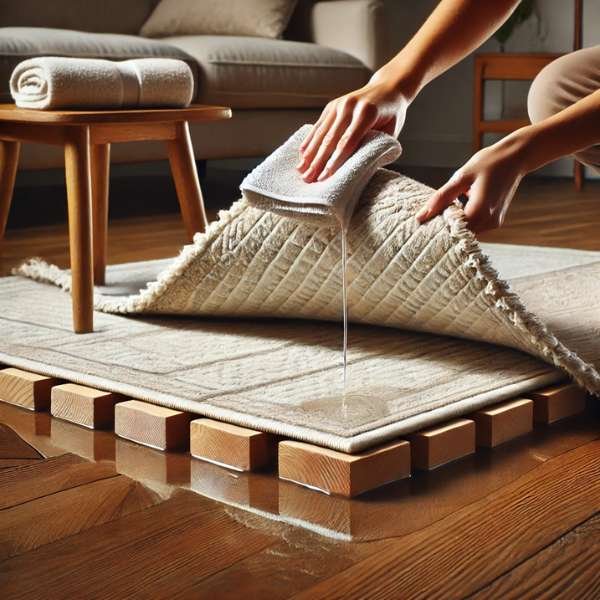
Drying properly is just as important as cleaning. After removing excess moisture, use towels to blot and allow air to circulate under the carpet by lifting it slightly. This prevents mold and mildew from forming and damaging both the carpet and the hardwood floor.
Maintaining Hardwood Floors After Rug Cleaning

Once the rug is clean, don’t forget about the hardwood underneath. A quick wipe-down with a microfiber cloth and floor cleaner keeps it shining. Just make sure the floor is completely dry before placing the carpet back down to prevent moisture from getting trapped.
Using Rug Pads to Protect Your Hardwood Floors and Keep Rugs in Place

One of the simplest yet most effective ways to safeguard your hardwood floors is by using a rug pad. Not only do these pads prevent slipping, but they also act as a buffer, reducing friction that can lead to scratches over time. Look for pads made from natural materials like felt or rubber. They’re gentle on hard lumber floors and provide extra cushioning, extending the life of both the carpet and the floor beneath.
How to Safely Move Furniture Off the Rug Without Scratching the Hardwood Floor

Moving furniture can feel like a risk to your pristine hardwood. One careless move, and you’re looking at a deep scratch. Before cleaning your rug, you may need to relocate furniture. Don’t drag it—lift it if possible. If lifting is difficult, slide felt pads or towels under the legs of the furniture to protect the floor. These simple precautions prevent damage while ensuring your cleaning process goes smoothly.
Eco-Friendly Rug Cleaning Tips That Won’t Harm Hardwood Floors

In today’s world, eco-friendly cleaning solutions are a win-win. Vinegar and water? Perfect for keeping both the carpet and the floor safe. Baking soda? A powerful, natural deodorizer that neutralizes odors without harmful residues. For those looking for a greener option, steam cleaning is an eco-conscious method. Just be cautious with the moisture levels, as too much can warp the hardwood.
How Humidity Affects Both Your Area Rug and Hardwood Floor

Humidity can wreak havoc on both your area rug and hardwood floors. Too much humidity? You’re inviting moisture, which leads to mold, mildew, and potential warping of the wood. Too little? hard lumber floors can crack, and your carpet’s fibers may become brittle. To strike the right balance, use a dehumidifier in damp months and a humidifier in drier conditions to keep everything in harmony.
Seasonal Rug Cleaning Tips: Keeping Rugs Clean in High Traffic Areas

Area rugs in high-traffic zones demand extra attention, especially as seasons change. In winter, road salt and moisture can wreak havoc, while summer brings dust and pollen. Adopt a seasonal cleaning routine to keep things fresh. Regular vacuuming, spot treatments, and a deep clean when necessary will preserve the carpet and the hardwood beneath. A carpet mat adds another layer of protection during these high-wear months.
How to Rotate Your Rug to Prevent Uneven Wear on Hardwood Floors
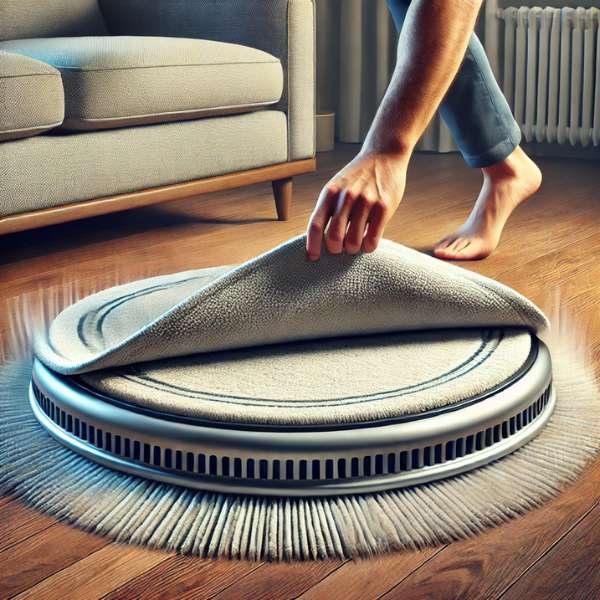
A simple rotation can prolong the existence of both your rug and hardwood floors. Over time, sure sections of the carpet may also revel in extra foot visitors than others, leading to choppy put-on. By rotating the carpet every 3 to 6 months, you distribute the wear greater frivolously, protecting both the carpet and the hard lumber floor from concentrated damage.
Long-Term Rug Care: How to Keep Your Area Rug Looking Fresh

Long-time period care for your vicinity rug boils right down to consistency. Regular vacuuming, set-off spot cleansing, and periodic deep cleaning all contribute to the carpet’s sturdiness. Every now after which, air it out to prevent any lingering odors from setting in. With constant renovation, your carpet will retain its vibrancy, and your hard lumber ground will stay pristine for future years.
Preventing Damage to Hardwood Floors from Rugs and Cleaning Products

The relationship between rugs and hardwood floors can be harmonious, but handiest in case you’re cautious. Harsh cleansing products can seep through the carpet and damage the ground beneath, and carpet backings can scratch the wood. Stick to pH-impartial, gentle cleaners, and constantly use a carpet pad to provide a protective barrier between the carpet and the floor. It’s a small funding with large returns in ground safety.
How to Prevent Mold and Mildew on Rugs Over Hardwood Flooring

Moisture is the enemy here. Whether from a spill or just a damp environment, moisture can lead to mold and mildew growth on your carpet, which can then transfer to the hardwood. After cleaning, ensure the carpet is completely dry before laying it back down. In humid environments, consider using a dehumidifier to keep things in check. Always avoid placing rugs in areas that are prone to moisture buildup, like near doors or windows.
When to Seek Professional Help for Cleaning Your Rug on Hardwood Floors
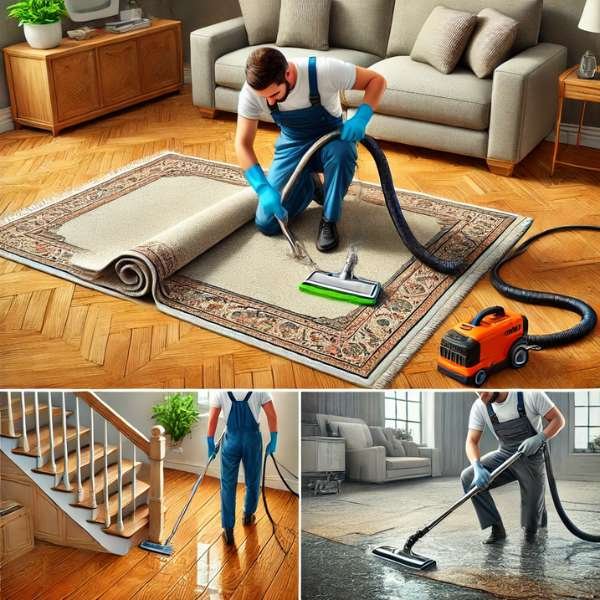
Sometimes, despite your best efforts, a DIY approach just won’t cut it. Whether it’s a persistent stain, an odor that won’t go away, or delicate rug fibers that require special attention, professional help may be necessary. Experts can deep clean your carpet without risking damage to the hard lumber beneath, and they’ll have the tools and experience to handle tougher issues. If your hardwood floors have suffered water damage or staining, a flooring expert can restore them to their original beauty. Knowing when to seek professional assistance can save both your carpet and your floors.
The Importance of Regular Maintenance for Both Your Rug and Hardwood Floors

Consistent maintenance is the secret to keeping both your area rug and hardwood floor in top shape. Dirt and dust buildup is inevitable, but a regular cleaning routine minimizes the long-term impact. Vacuuming weekly, addressing spills immediately, and deep cleaning periodically ensure that both your carpet remains fresh and your hard lumber continues to gleam. The payoff? No need for costly repairs or replacements down the line.
Conclusion:
Cleaning an area carpet on hardwood floors isn’t just an ordinary chore—it’s a balancing act between preserving the carpet’s splendor and protecting the ground’s integrity. With the right equipment, a thoughtful method, and a dedication to regular care, you could maintain each looking pristine for years yet to come. Cleanliness and care don’t ought to be at odds; in reality, they go hand in hand to maintain the beauty of your house.

